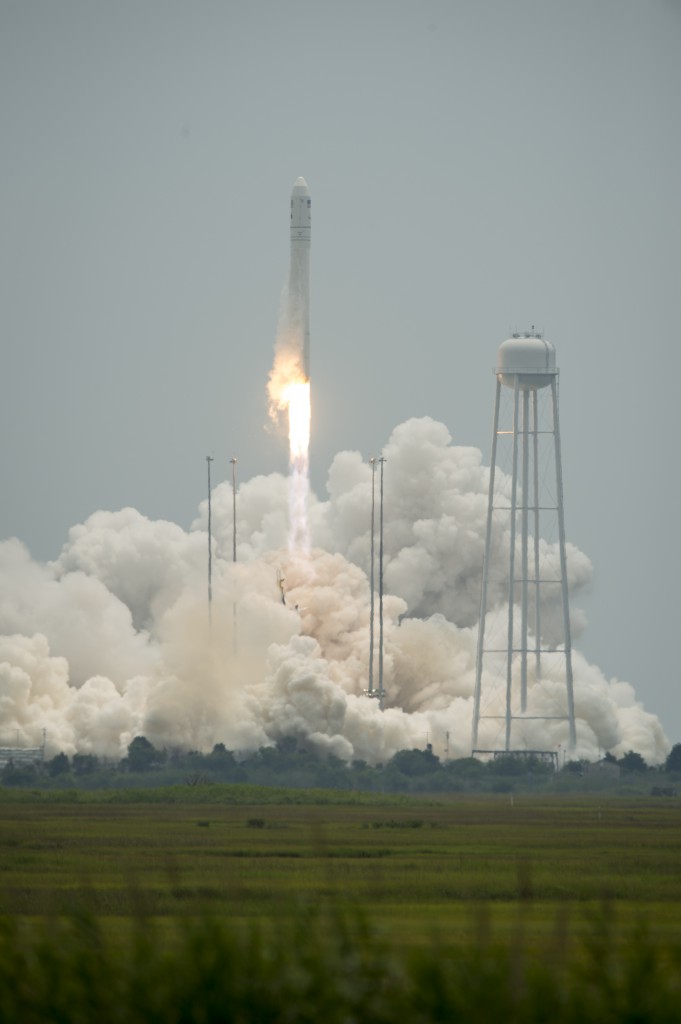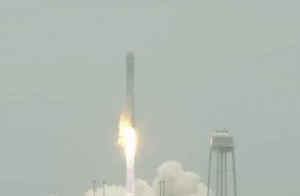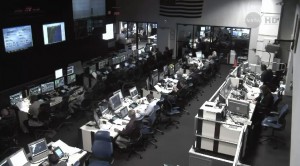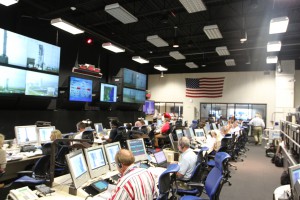
Category: Cygnus
Second Stage Burn, Spacecraft Separation Complete
Cygnus’ second stage has lifted the spacecraft into its initial orbit. Cygnus has separated from the second stage. Cygnus is about 125 miles high, traveling at more than 16,700 mph.
Cygnus will then deploy its solar arrays and begin a carefully choreographed series of engine firings to reach the station.
Orbital Sciences Corp.’s Cygnus spacecraft with cargo for the International Space Station launched as scheduled at 12:52 p.m. EDT aboard an Antares rocket from the Mid-Atlantic Regional Spaceport Pad 0A at NASA’s Wallops Flight Facility in Virginia. Rendezvous of Cygnus with the space station is scheduled for the morning of July 16.
› NASA’s Orbital website
› Launch viewing maps from Orbital Sciences Corp.
› Latest Student Science Heads For Space
› Orbital Mission Delivers Delights to Station
› NASA Launches Smartphone Upgrade and CubeSat
Main Engine Cutoff and 1st Stage Separation
“MECO,” or main engine cutoff and first stage separation have occurred.
Liftoff!
 Orbital Sciences Corp.’s Cygnus spacecraft with cargo for the International Space Station launched as scheduled at 12:52 p.m. EDT aboard an Antares rocket from the Mid-Atlantic Regional Spaceport Pad 0A at NASA’s Wallops Flight Facility in Virginia. Rendezvous of Cygnus with the space station is scheduled for the morning of July 16.
Orbital Sciences Corp.’s Cygnus spacecraft with cargo for the International Space Station launched as scheduled at 12:52 p.m. EDT aboard an Antares rocket from the Mid-Atlantic Regional Spaceport Pad 0A at NASA’s Wallops Flight Facility in Virginia. Rendezvous of Cygnus with the space station is scheduled for the morning of July 16.
› NASA’s Orbital website
› Launch viewing maps from Orbital Sciences Corp.
› Latest Student Science Heads For Space
› Orbital Mission Delivers Delights to Station
› NASA Launches Smartphone Upgrade and CubeSat
Final Countdown Poll: ‘Go!’

With roughly 11 minutes left in the countdown, the Orbital Sciences and NASA launch teams gave approval to launch as scheduled at 12:52 p.m. today. There are no technical issues and the weather remains 90-percent favorable.
Orbital Sciences Corp.’s Cygnus spacecraft is now on internal power.
Loaded with cargo for the International Space Station, Cygnus is launching aboard an Antares rocket from the Mid-Atlantic Regional Spaceport Pad 0A at NASA’s Wallops Flight Facility in Virginia.
At the time of the Antares launch, the space station will be over Australia. Rendezvous of Cygnus with the space station is scheduled for the morning of July 16.
› NASA’s Orbital website
› Launch viewing maps from Orbital Sciences Corp.
› Latest Student Science Heads For Space
› Orbital Mission Delivers Delights to Station
› NASA Launches Smartphone Upgrade and CubeSat
Fuel Line Chill-Down Under Way
With about 30 minutes until launch at 12:52 p.m. EDT, chilling of the Antares rocket’s fuel lines is proceeding as planned. These lines are cooled to ensure efficient delivery of the fuel to the main engines at the time of ignition.
The U.S. Coast Guard helped ensure a sailboat exited the launch hazard area earlier in the countdown.
› NASA’s Orbital website
› Launch viewing maps from Orbital Sciences Corp.
› Latest Student Science Heads For Space
› Orbital Mission Delivers Delights to Station
› NASA Launches Smartphone Upgrade and CubeSat
Antares Fueling Continues

Fueling of the first stage of the Antares rocket with liquid oxygen and rocket-grade kerosene started began about an hour-and-a-half before the scheduled launch time of 12:52 p.m. EDT today, July 13.
Weather continues to be good and no significant issues are being worked.
› NASA’s Orbital website
› Launch viewing maps from Orbital Sciences Corp.
› Latest Student Science Heads For Space
› Orbital Mission Delivers Delights to Station
› NASA Launches Smartphone Upgrade and CubeSat
View of the Launch Pad

The countdown is progressing smoothly today for the launch of Orbital Sciences Corporation’s Antares rocket, with the Cygnus cargo spacecraft on top. With roughly 2 hours, 12 minutes left in the countdown, weather remains 90 percent “go.”
Liftoff is scheduled for 12:52 p.m. EDT from the Mid-Atlantic Spaceport’s Pad 0A at NASA’s Wallops Flight Facility in Virginia. There is a five minute window for launch.
Live coverage of the launch on NASA TV will begin at noon, with general footage of the mission airing at 11:30 a.m.
Cygnus is loaded with about 3,300 pounds of science investigations, food, supplies and hardware for the space station and its crew.
A launch this afternoon will result in Cygnus catching up to the space station on Wednesday, July 16. Cygnus will be grappled at approximately 6:39 a.m. by Commander Steve Swanson of NASA. He will be assisted in a backup position by Flight Engineer Alexander Gerst of the European Space Agency. Cygnus will be attached to the Earth-facing port of the station’s Harmony node and will remain in place approximately one month. It is scheduled depart the space station on August 15.
This is Orbital’s second contracted mission to the International Space Station under its Commercial Resupply Services contract with NASA.
› NASA’s Orbital website
› Launch viewing maps from Orbital Sciences Corp.
› Latest Student Science Heads For Space
› Orbital Mission Delivers Delights to Station
› NASA Launches Smartphone Upgrade and CubeSat
Launch Day Rundown

Orbital Sciences Corp.’s Cygnus spacecraft with cargo for the International Space Station is scheduled to launch aboard an Antares rocket on Sunday, July 13 at 12:52 p.m. EDT. Liftoff will be from the Mid-Atlantic Regional Spaceport Pad 0A at NASA’s Wallops Flight Facility in Virginia. NASA Television coverage of the launch will begin at noon.
The countdown to the launch starts at T-minus 3 hours, 50 minutes, roughly 9 a.m., and features a number of “holds.” These planned pauses vary in length, but they all allow the team to target a precise launch window and provide a cushion of time for various tasks and procedures without affecting the overall schedule.
The launch window (that is, the time period on any given launch day in which liftoff must occur for the spacecraft to reach its target) on July 13 is about five minutes long.
https://www.youtube.com/watch?v=https://www.youtube.com/watch?v=xwSCGP3R_dg[/embedyt]
This animation depicts an Antares launch and the flight and capture of a Cygnus capsule.
The liquid-fueled first stage of Antares ignites at T-minus zero, and the rocket lifts off about two seconds later.
“MECO,” or main engine cutoff, occurs about four minutes after that, at which point Antares will be about 63 miles high, traveling about 10,118 mph. The first stage separates a few seconds later. About 90 seconds later, the fairing (the protective covering around Cygnus at the top of the rocket) opens and separates.
The solid-fueled second stage ignites and burns for a bit longer than two minutes. Two minutes after that burn, the payload (that is, the Cygnus cargo spacecraft) separates from the second stage. At that point, Cygnus will be about 125 miles high, traveling at 16,835 mph.
Just over 10 minutes after launch, Cygnus will reach its preliminary orbit, deploy its solar arrays and begin a carefully choreographed series of engine firings to reach the station.
› NASA’s Orbital website
› Latest Orb-2 TV launch coverage information
› Launch viewing maps from Orbital Sciences Corp.
› Latest Student Science Heads For Space
› Orbital Mission Delivers Delights to Station
› NASA Launches Smartphone Upgrade and CubeSat
Results of Orb-2 Launch Readiness Review
At a Launch Readiness Review Saturday, managers for Orbital Sciences Corp. of Dulles, Virginia, and NASA gave a “go” to proceed toward the Sunday, July 13, launch of the Orb-2 cargo resupply mission to the International Space Station. Orbital is targeting a 12:52 p.m. EDT launch from the Mid-Atlantic Regional Spaceport Pad 0A at NASA’s Wallops Flight Facility in Virginia. NASA Television coverage of the launch will begin at noon.
There is a 90-percent chance of favorable weather at the time of launch.
A pre-launch news briefing was held at 4:30 p.m.on Saturday, July 12, at the Wallops visitors center, to discuss the status of the mission.
› NASA’s Orbital website
› Latest Orb-2 TV launch coverage information
› Launch viewing maps from Orbital Sciences Corp.
› Latest Student Science Heads For Space
› Orbital Mission Delivers Delights to Station
› NASA Launches Smartphone Upgrade and CubeSat
